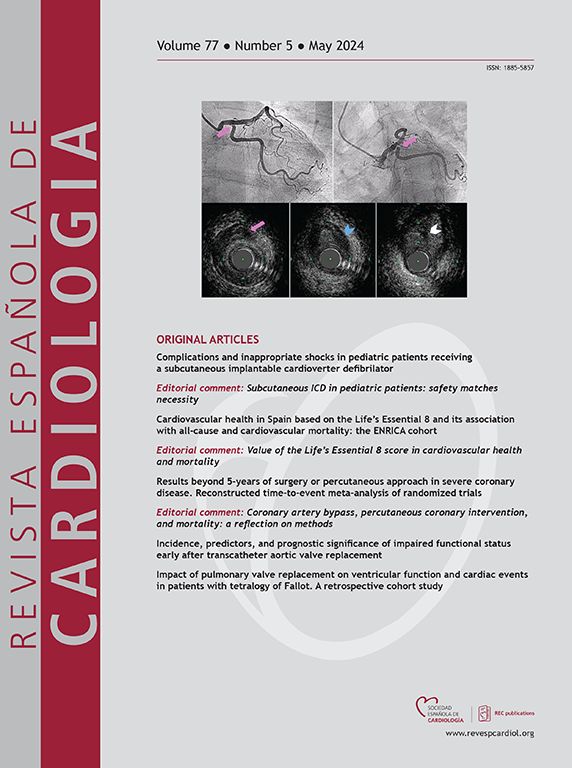多血管疾病急性心肌梗死的心源性休克:按缺血区划分的血管再通策略
IF 5.9
2区 医学
Q2 Medicine
引用次数: 0
摘要
在急性心肌梗死合并心源性休克(AMI-CS)患者中,根据非罪魁祸首病变的缺血范围,血运重建策略与临床结果的关联尚未有文献记载。本研究的目的是根据AMI-CS患者的缺血区域,比较单纯犯罪者和即时多血管经皮冠状动脉介入治疗(PCI)的结果。方法将SMART-RESCUE登记的536例AMI-CS和多血管疾病患者根据缺血区域(非罪魁祸首左主/近端左前降支[LM/pLAD]、罪魁祸首LM/pLAD、无LM/pLAD)进行分类。主要终点为以患者为导向的复合终点(POCE),包括全因死亡、心肌梗死、心力衰竭再住院或1年后重复血运重建。结果总体人群中,非罪魁祸首LM/pLAD患者108例,罪魁祸首LM/pLAD患者228例,无罪魁祸首LM/pLAD患者200例,大缺血区域病变患者发生POCE的风险更高(53.6% vs 53.4% vs 39.6%;P = .02)。在非罪魁祸首LM/pLAD患者中,与仅行罪魁祸首PCI相比,多血管PCI与POCE风险显著降低相关(40.7% vs 66.9%;人力资源,0.52;95%置信区间,0.29 - -0.91;P = .02),但在罪魁祸首LM/pLAD (P = .46)或无LM/pLAD (P = .47)中没有。血运重建策略与大面积非罪魁祸首缺血区域之间存在显著的相互作用(P = .03)。结论AMI-CS合并多血管病变患者的大面积缺血受累与较差的临床预后相关。立即多血管PCI可能改善非罪魁祸首缺血性负担大的患者的临床结果。本文章由计算机程序翻译,如有差异,请以英文原文为准。
Shock cardiogénico en el infarto agudo de miocardio con enfermedad multivaso: estrategia de revascularización según el territorio isquémico
Introduction and objectives
The association of revascularization strategy with clinical outcomes according to the ischemic territory of nonculprit lesion has not been documented in patients with acute myocardial infarction complicated by cardiogenic shock (AMI-CS). This study aimed to compare outcomes between culprit-only and immediate multivessel percutaneous coronary intervention (PCI) according to ischemic territory in patients with AMI-CS.
Methods
A total of 536 patients with AMI-CS and multivessel disease from the SMART-RESCUE registry were categorized according to ischemic territory (nonculprit left main/proximal left anterior descending artery [LM/pLAD] vs culprit LM/pLAD vs no LM/pLAD). The primary outcome was a patient-oriented composite endpoint (POCE) consisting of all-cause death, myocardial infarction, rehospitalization due to heart failure, or repeat revascularization at 1 year.
Results
Among the total population, 108 patients had nonculprit LM/pLAD, 228 patients had culprit LM/pLAD, and 200 patients had no LM/pLAD, with the risk of POCE being higher in patients with large ischemic territory lesions (53.6% vs 53.4% vs 39.6%; P = .02). Multivessel PCI was associated with a significantly lower risk of POCE compared with culprit-only PCI in patients with nonculprit LM/pLAD (40.7% vs 66.9%; HR, 0.52; 95%CI, 0.29-0.91; P = .02), but not in those with culprit LM/pLAD (P = .46) or no LM/pLAD (P = .47). A significant interaction existed between revascularization strategy and large nonculprit ischemic territory (P = .03).
Conclusions
Large ischemic territory involvement was associated with worse clinical outcomes in patients with AMI-CS and multivessel disease. Immediate multivessel PCI might improve clinical outcomes in patients with a large nonculprit ischemic burden.
求助全文
通过发布文献求助,成功后即可免费获取论文全文。
去求助
来源期刊

Revista espanola de cardiologia
医学-心血管系统
CiteScore
4.20
自引率
13.60%
发文量
257
审稿时长
28 days
期刊介绍:
Revista Española de Cardiología, Revista bilingüe científica internacional, dedicada a las enfermedades cardiovasculares, es la publicación oficial de la Sociedad Española de Cardiología.
 求助内容:
求助内容: 应助结果提醒方式:
应助结果提醒方式:


